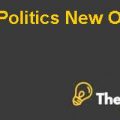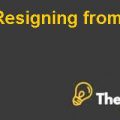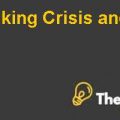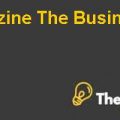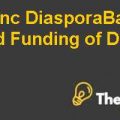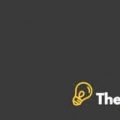HAMBURGUESAS EL CORRAL Case Study Solution
Threats:
- El corral had maintained a stable position as a market leader in fast food industry. Although, McDonalds had established its roots in Colombia in year 1992 but in 2012 it had taken over El Corral after it gained 20% market share beating El Corral after a tough competition.
McDonald had come up with better plans and offered delivery service since its inception in Colombia, and this made a difference for El Corral. The Rival’s performance was better in many different areas of fast food service which wasn’t done by El Corral. For instance, all the McDonalds stores had self-servicing topping areas where customers could top up with pickles, and other sauces. Moreover, McDonalds also offered variety in their menu, which included alternative kids menu with delicious meals and healthy juices. All of this gave an upper hand to McDonalds and it posed severe threat to El Corral.
- Government imposes different regulations and stricter rules for the health and diet of its citizen. For it, El Corral will have to change its product line and this may reduce down their profits.
Macro-environmental Analysis
El Corral’s external environment can change the company’s dynamics and it can impact the company’s bottom line. To further analyze the external analysis, PESTEL analysis has been done below:
Political Factors:
- As the company looks for suppliers, that are registered with manufacturing license which is issued by Colombia’s health Ministry. Now, if the health Ministry changes its rule and shows leniency on issuing the license that it can become pose problem for the company. The suppliers may provide lesser quality products to El Corral which will dissatisfy their customers.
- Colombia had gone into free trade agreements which allowed other competitors to enter the market which actually disturbed El Corral’s business. Also, it gave an opportunity for the company to expand into different world markets.
- If Colombia will have better relationship with the foreign countries then El Corral can have better opportunity to collaborate with foreign suppliers like McCain for fries and Nestle for different dairy products.
- New public health policies can deter the company’s growth because it might lower down the customer’s presence in their restaurants. This might hamper the business and may reduce the profitability.
Economic Factors:
- Colombian economy had grown by 10.9% after 2010 and was expected to reach 4.3% by 2013. An improved economy meant that more people could buy fast food and the demand for El Corral’s products will increase.
- The country was controlling down its poverty which meant that people were getting better off and their income levels were increasing which meant now they could eat more from El Corral fast food menu. The poverty level was down by 4.5% from 2010.
- The people were spending a total of $12.1 billion on eating out of which $2 billion was spent on fast food restaurant, indicating that there were positive signs coming ahead for El Corral Company.
- Country’s employment rate can impact a company’s growth. If unemployment rate is high, El Corral could get the workers at its desired salary. By doing this, salary expenses of the company will shrink down improving the overall profitability of the company. On the other hand, an economy with low unemployment rate will negatively affect the company’s bottom line. When there will be les supply of labor, the workers will demand the salaries on their terms and El Corral will have to pay them. This would mean that salary expenses will shoot up and will be a burden on income statement.
Sociocultural Factors:
- Improved Customer lifestyles allows them to eat at expensive restaurants and will allow El Corral to increase its prices as it can be afforded by the people.
- As people are getting busier with their professional lifestyle, they rely on fast food to give relief to their hunger. The demand of fast food takes a hike which is positive for the fast food giant.
- Nowadays people are getting conscious regarding their health and prefers organic and green food over non-veg items. Also, a healthy lifestyle trend would mean that people wouldn’t want to eat fast food as much as they did before which is negative for El Corral.
Technological factors:
- El Corral lacked proper technology to deliver their food items and that is why they were getting behind McDonalds in the leadership race in the fast food industry.
- McDonald invested in battery powered induction heating boxes so that it could deliver its product hence, El Corral could do the same and take advantage of the technology.
- With the advent of social media, El Corral can market its product on Facebook and Instagram and increase its sale with minimal cost.
Environmental Factors:
- Climatic changes in some areas might affect the company’s business.
- El Corral can make better environmental programs to give strength to its business performance and brand.
Legal Factors:
- Animal right organizations has worked quite hard to increase animal welfare awareness and the legal laws has imposed regulations on killing animals. Getting meat would become problematic for the El Corral.
- In many parts of the world, labor laws are getting stricter. With this, the minimum labor wage has risen which can be bad for the company’s profitability.
- The accessibility and availability of fast food gets limited to the health regulations for school children and some workplaces.
Competitive Analysis
El Corral was one of the few fast food restaurant which was introduced in Colombia in 1980 though just after a decade and half, McDonalds set its foot in the Colombian fast food market in the year 1995. The unique strategy called Plan to win was different from the already established fast food rival, El Corral. As McDonalds gained strength, it continuously grabbed market share away from El Corral and after a constant struggle to dethrone El Corral, McDonald gained the largest market share at 20% in 2013.
McDonalds believed in providing the best food to its customers and giving them the best service therefore, satisfying them completely. There motive was to enhance the customers’ experience and for that it had used segmentation policy. They shifted their focus away from the adults and targeted their services towards the young kids as they believed that they were the ones influencing the parents’ decision to choose which fast food restaurant to eat from. The company created play areas for them so that they could enjoy their time in McDonalds while playing with other children while they also designed a special kids menu to attract kids. People now looked at the McDonalds with trust because their kids loved it and they thought that the restaurant could do anything to satisfy them.
Moreover, since its beginning, McDonalds had an upper hand over other competitors when it brought the idea of home delivery to the Colombian market which it first used in Egypt in 1995. The company was delivering its foods to all the customers and was on the top of the list whenever their customers wanted to order something at home. Investing in technology proved to be fruitful for the restaurant as the orders were carried in battery powered heating box which could keep their food away from humidity. El Corral didn’t trust the technology that well and thought that delivery service could ruin their fresh fast food products.
McDonalds introduced “one-dollar menu” to bridge the gap that was created by the declining sales. The one- dollar menu was an instant hit amongst the families which was clearly reflected upon their financials when the sales had picked up with the customers transaction. This was one of the way to capture the market share because El Corral couldn’t think of any such strategies to overcome McDonalds. Exhibit 2 shows some of the comparative feature of both El Corral and McDonalds
Alternatives
The meeting was conducted to discuss various issues for declining market share and one of the team members discussed the two alternatives:
No- home delivery Service:
The El Corral members knew that delivery service was getting trendy within the fast food industry. But they had some strong reservations over this new change. The team was comparing their food items with that of Chinese food like sushi and thought that their food product would deteriorate during the delivery. Fast foods comes up fresh and it should be eaten right away rather than waiting for too long. They discussed that the Colombian traffic issue would make it difficult for the food to be delivered on time. If the food stays too long in the delivery box its sauce will permeate in the bun and will make it less desirable.
The team also feared that by looking at the low quality hamburger, the customer might return back their product which would be worse than no delivery service. Also, they thought that they do not have the complete technology for their products to reach at customers place in proper condition. As a result, they gave an option to completely forget about the delivery service as for them it had more drawbacks than the advantages.
El Corral Home:
The second idea was to completely launch a new brand with the name of El Corral Home which could cater the online market where people could order the food at their home. The idea was motivated by their already established brand El Corral Gourmet. However, El Corral Gourmet seemed to be different from the new idea. El Corral home was said to focus primarily on providing delivery service to the customers sitting at home. This meant that there was no place for waiters in this new venture as it also had few modified product offerings. The customized product offering would mean that now the customers could get their own choice of food and they could customize it at their own wish. Plus, with that they would get the facility to get the product delivered at their home. The team member thought that this could prove to be a good idea and it could well compete with the McDonalds because now, El Corral loyal customers wouldn’t need to order fast food from McDonalds. Also, a better relationship between customers and the company can be assured.
Cost determination of free delivery service
People living in Bogota had to cover long distances and lousy traffic along with bad weather so they preferred ordering at home rather than dining-in. To avail greater sales and in an attempt to be the first choice for customers, many fast food companies including McDonalds offered free delivery services. Giving the companies a sharper competitive advantage over other firms. If going for the free delivery option, El corral would be hiring new riders. According to the data, the average labor earns $7.5 per hour who will be working for nine hours, hence taking up the labor cost per day to $67.5. After that, the gasoline charges are $0.78/lit which has given fuel cost per lite per month of $58.5. Now the total costs per day is $69.45.
Moving towards to revenue, although the cost has been calculated for the free delivery, but a customer can only avail the free deliver services only with a minimum order of $10. As the company is at the experimental stages of free delivery it is expected to receive 300 orders outlets at the initial stages. This means that the company will earn $3000 in the revenues. Continuing with that, deducting total cost of fuel and labor, the company will have its average day’s profit of $2930 and an annual income of $87,916.
Recommendations
After analyzing the problem it can be said that the El Corral was behind the race as the best fast food giant in the Colombian fast food market. McDonalds had taken its place which was caused by one advantage that it had over El Corral which was the delivery service that McDonalds had offered but El Corral opted not to.
The team meeting had two option whether to go for the no delivery service or to go for a new brand that was El Corral Home that mainly focused on delivering the food with modified products. Now, El Corral had problems in getting the right technology to deliver their product on time and as such that the food remains fresh. They were particularly concerned about the quality of the food that would not be the same as it would have been in the restaurant. Although, McDonalds was using the same delivery service since the beginning in Colombia and was having a good success at it. The investment in good technology meant that their food item would remain fresh throughout the delivery period. The idea of getting the food delivered at home was liked by the new generation of eaters and hence, McDonalds was right on the top of the list for them to order online. Meanwhile, El Corral was nowhere to be found in that list although it was offering quality products.
The trend has changed and the company needs to realize they have to follow the trend. Right now, in this age people prefer to order their food online and hence the company’s does require quality home-delivery service. If they have to compete in the market with rivals like McDonalds then it has to invest in the latest technology that could help them deliver their food items right on time and making sure that it remains fresh and of high quality.............
This is just a sample partical work. Please place the order on the website to get your own originally done case solution.


